Abstract
Gangliosides are known to be actively shed from tumour cell membranes, and increased levels of circulating gangliosides may cause tumour-induced T-lymphocyte immunosuppression in vivo by interfering with the actions of interleukin-2 (IL-2). We have investigated the effect of gangliosides on the interaction of IL-2 with its cell surface receptors (IL-2R). Gangliosides inhibited IL-2-stimulated proliferation in synchronized populations of the IL-2-dependent cell lines CTLL-2 and HT-2. The immunosuppressive effect was most effective when gangliosides were added during the first 4 hr after IL-2-stimulation, indicating that they acted early in the IL-2 signalling pathway. Inhibition could be completely overcome by exogenous IL-2, suggesting that gangliosides inhibited growth solely by competing with IL-2R for available IL-2. In support of this proposal, gangliosides induced a concomitant dose-dependent decrease in binding of [125I]IL-2 to high-, medium- and low-affinity IL-2R. Ganglioside-treated cells recovered their high-affinity [125I]IL-2 binding after washing. The glycolipids also prevented chemical cross-linking of [125I]IL-2 to the p55/p75 complex, as well as to both IL-2R alpha (p55) and IL-2R beta (p75) independently. A thin-layer chromatography overlay technique was used to demonstrate that IL-2 binds directly to gangliosides, but not to simple neutral glycolipids or acidic lipids. Taken together, these findings indicate that gangliosides directly block the interaction of IL-2 with IL-2R, and may explain, in part, the immunosuppressive activities of gangliosides in vivo.
Full text
PDF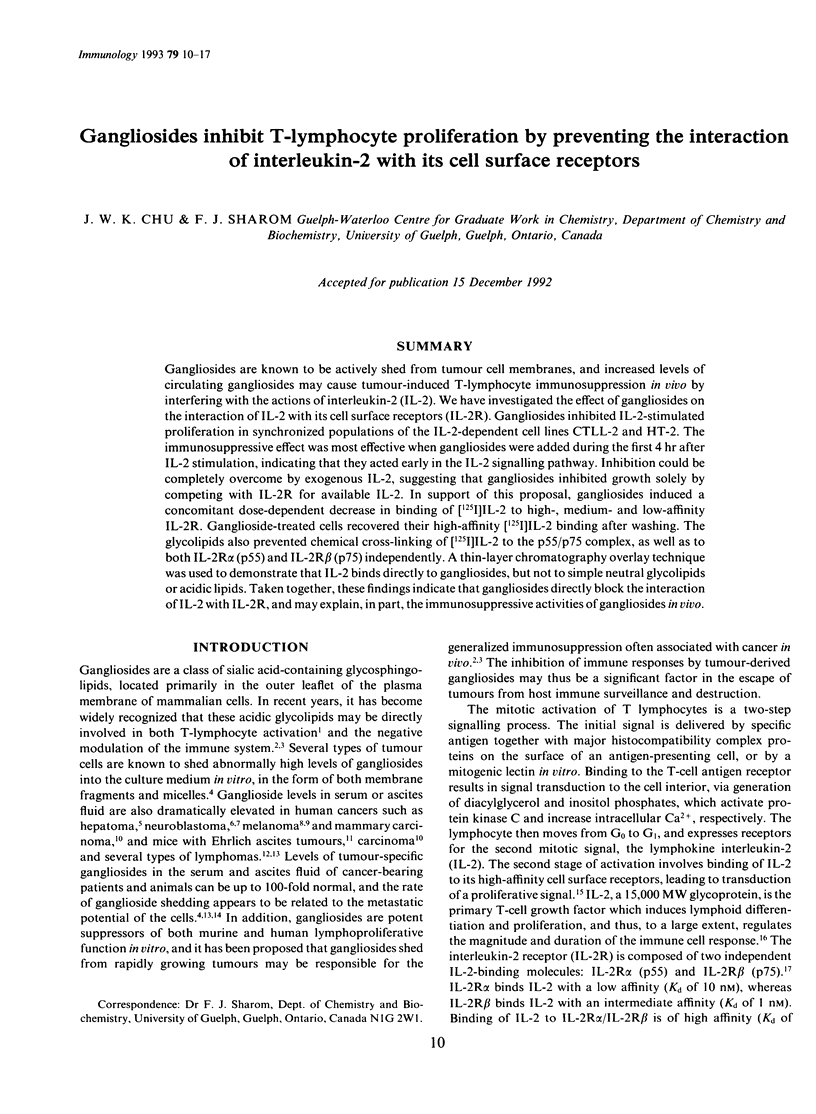
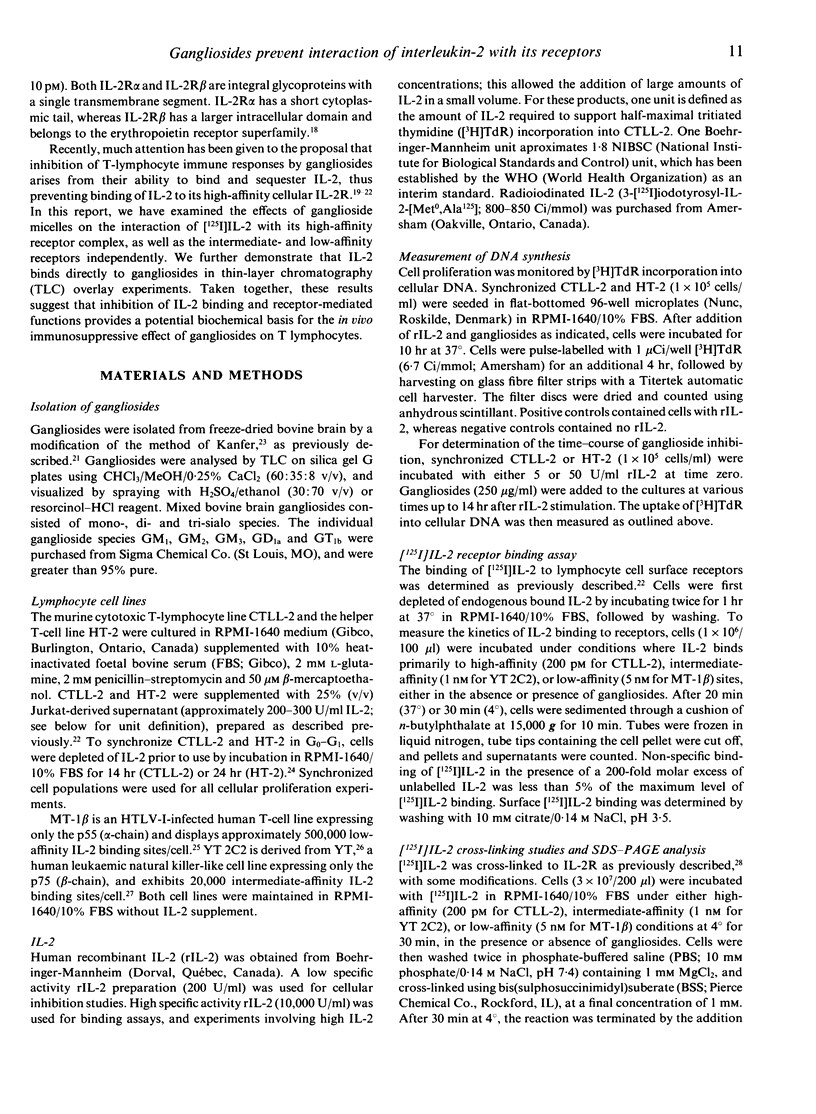
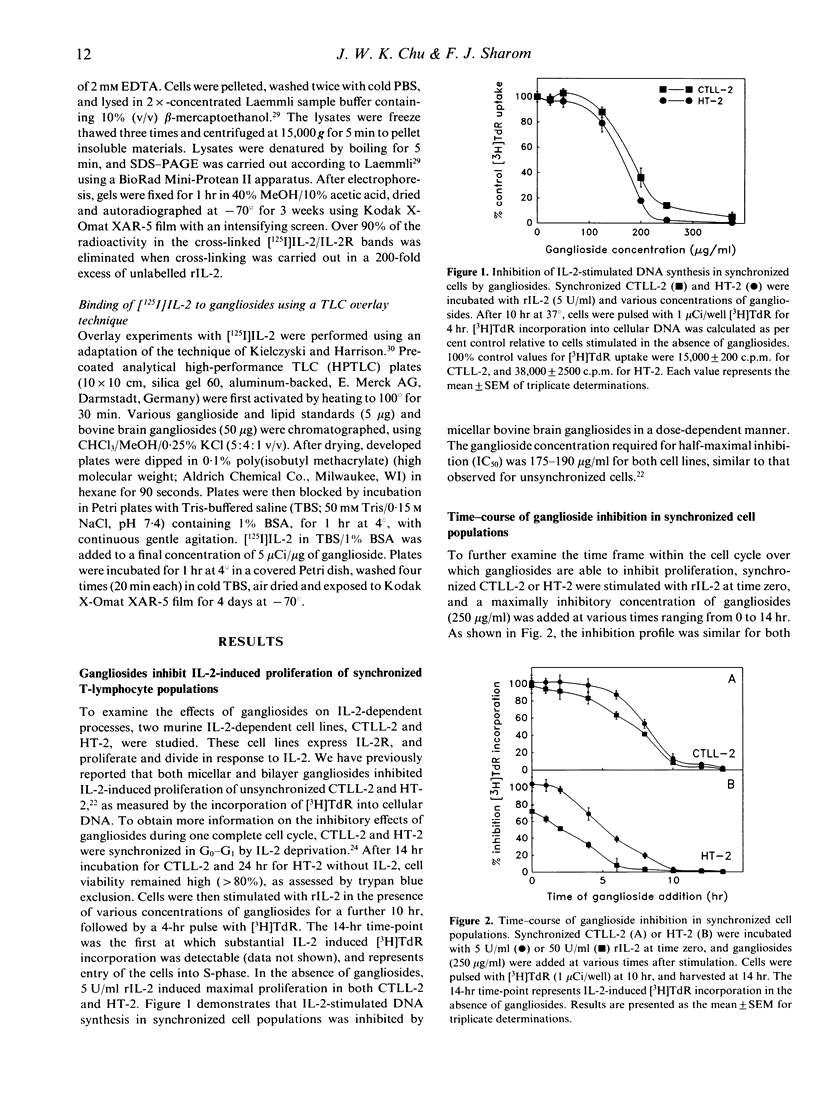
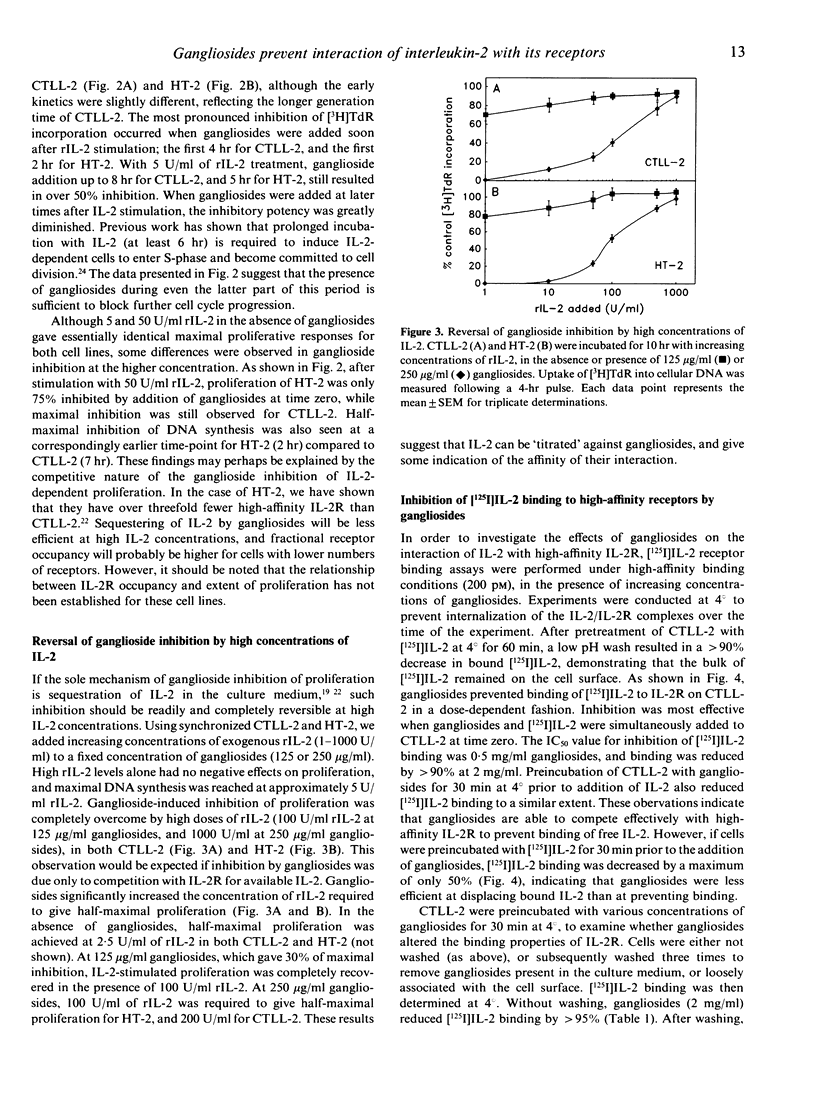

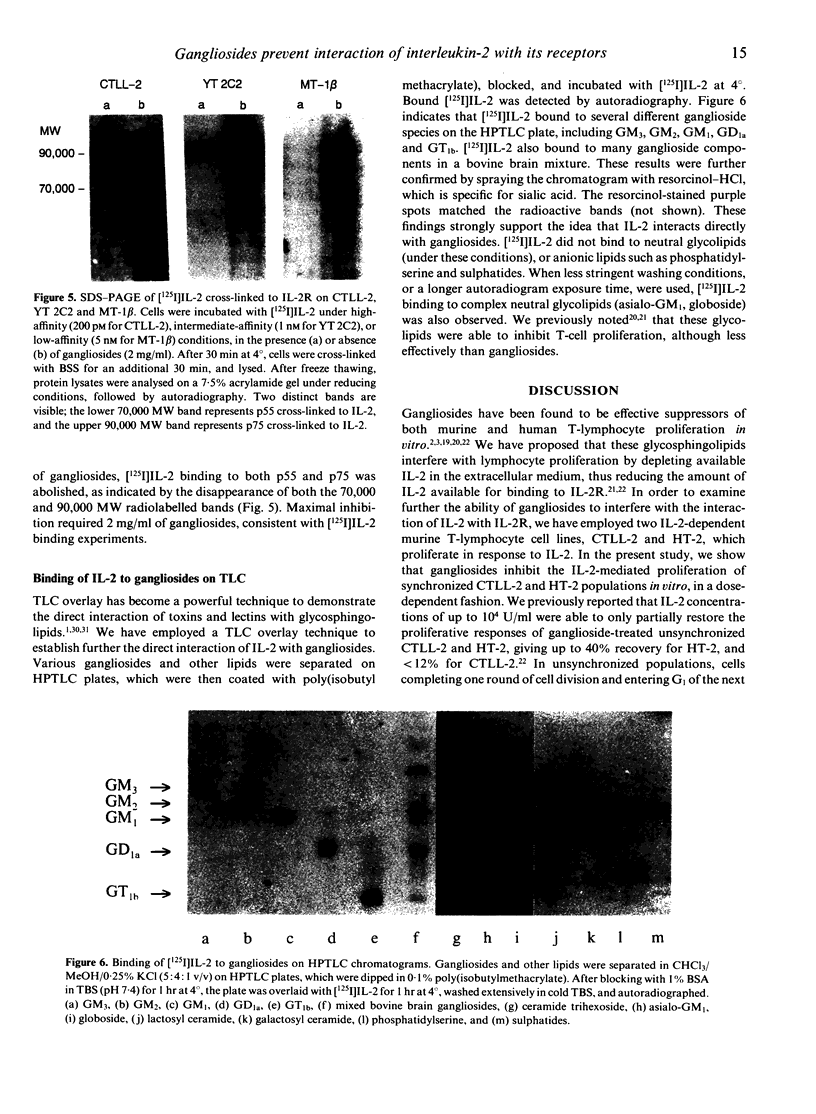
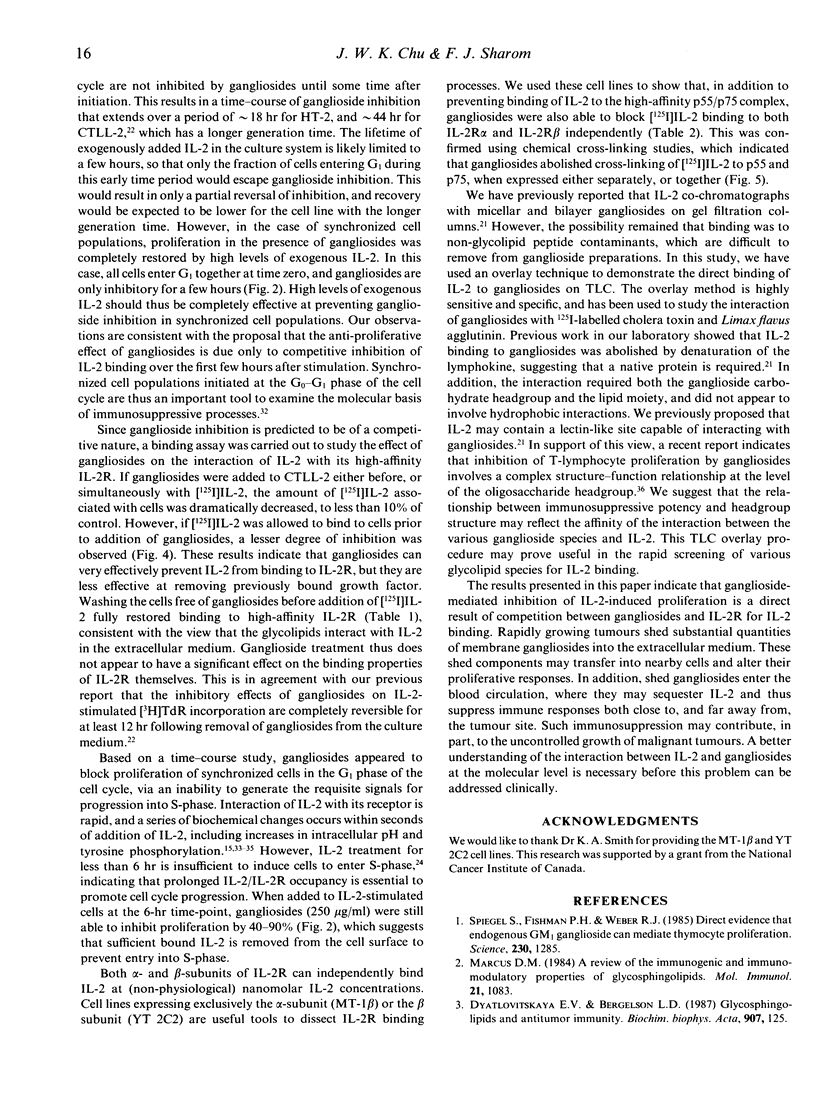
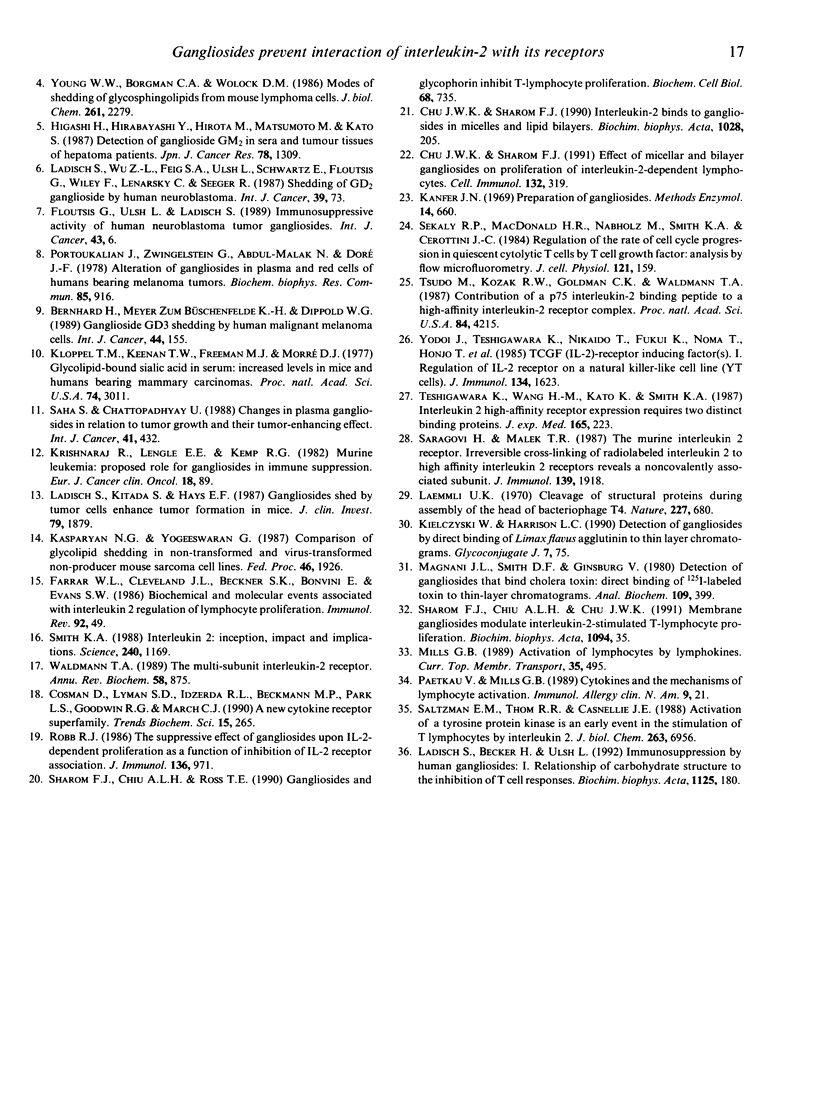
Images in this article
Selected References
These references are in PubMed. This may not be the complete list of references from this article.
- Bernhard H., Meyer zum Büschenfelde K. H., Dippold W. G. Ganglioside GD3 shedding by human malignant melanoma cells. Int J Cancer. 1989 Jul 15;44(1):155–160. doi: 10.1002/ijc.2910440127. [DOI] [PubMed] [Google Scholar]
- Chu J. W., Sharom F. J. Effect of micellar and bilayer gangliosides on proliferation of interleukin-2-dependent lymphocytes. Cell Immunol. 1991 Feb;132(2):319–338. doi: 10.1016/0008-8749(91)90031-6. [DOI] [PubMed] [Google Scholar]
- Chu J. W., Sharom F. J. Interleukin-2 binds to gangliosides in micelles and lipid bilayers. Biochim Biophys Acta. 1990 Oct 19;1028(3):205–214. doi: 10.1016/0005-2736(90)90168-n. [DOI] [PubMed] [Google Scholar]
- Cosman D., Lyman S. D., Idzerda R. L., Beckmann M. P., Park L. S., Goodwin R. G., March C. J. A new cytokine receptor superfamily. Trends Biochem Sci. 1990 Jul;15(7):265–270. doi: 10.1016/0968-0004(90)90051-c. [DOI] [PubMed] [Google Scholar]
- Dyatlovitskaya E. V., Bergelson L. D. Glycosphingolipids and antitumor immunity. Biochim Biophys Acta. 1987 Jul 8;907(2):125–143. doi: 10.1016/0304-419x(87)90002-3. [DOI] [PubMed] [Google Scholar]
- Farrar W. L., Cleveland J. L., Beckner S. K., Bonvini E., Evans S. W. Biochemical and molecular events associated with interleukin 2 regulation of lymphocyte proliferation. Immunol Rev. 1986 Aug;92:49–65. doi: 10.1111/j.1600-065x.1986.tb01493.x. [DOI] [PubMed] [Google Scholar]
- Higashi H., Hirabayashi Y., Hirota M., Matsumoto M., Kato S. Detection of ganglioside GM2 in sera and tumor tissues of hepatoma patients. Jpn J Cancer Res. 1987 Dec;78(12):1309–1313. [PubMed] [Google Scholar]
- Kloppel T. M., Keenan T. W., Freeman M. J., Morré D. J. Glycolipid-bound sialic acid in serum: increased levels in mice and humans bearing mammary carcinomas. Proc Natl Acad Sci U S A. 1977 Jul;74(7):3011–3013. doi: 10.1073/pnas.74.7.3011. [DOI] [PMC free article] [PubMed] [Google Scholar]
- Krishnaraj R., Lengle E. E., Kemp R. G. Murine leukemia. Proposed role for gangliosides in immune suppression. Eur J Cancer Clin Oncol. 1982 Jan;18(1):89–98. doi: 10.1016/0277-5379(82)90031-1. [DOI] [PubMed] [Google Scholar]
- Ladisch S., Becker H., Ulsh L. Immunosuppression by human gangliosides: I. Relationship of carbohydrate structure to the inhibition of T cell responses. Biochim Biophys Acta. 1992 Apr 23;1125(2):180–188. doi: 10.1016/0005-2760(92)90043-u. [DOI] [PubMed] [Google Scholar]
- Ladisch S., Kitada S., Hays E. F. Gangliosides shed by tumor cells enhance tumor formation in mice. J Clin Invest. 1987 Jun;79(6):1879–1882. doi: 10.1172/JCI113031. [DOI] [PMC free article] [PubMed] [Google Scholar]
- Laemmli U. K. Cleavage of structural proteins during the assembly of the head of bacteriophage T4. Nature. 1970 Aug 15;227(5259):680–685. doi: 10.1038/227680a0. [DOI] [PubMed] [Google Scholar]
- Magnani J. L., Smith D. F., Ginsburg V. Detection of gangliosides that bind cholera toxin: direct binding of 125I-labeled toxin to thin-layer chromatograms. Anal Biochem. 1980 Dec;109(2):399–402. doi: 10.1016/0003-2697(80)90667-3. [DOI] [PubMed] [Google Scholar]
- Marcus D. M. A review of the immunogenic and immuno-modulatory properties of glycosphingolipids. Mol Immunol. 1984 Nov;21(11):1083–1091. doi: 10.1016/0161-5890(84)90118-4. [DOI] [PubMed] [Google Scholar]
- Portoukalian J., Zwingelstein G., Abdul-Malak N., Doré J. F. Alteration of gangliosides in plasma and red cells of humans bearing melanoma tumors. Biochem Biophys Res Commun. 1978 Dec 14;85(3):916–920. doi: 10.1016/0006-291x(78)90630-7. [DOI] [PubMed] [Google Scholar]
- Robb R. J. The suppressive effect of gangliosides upon IL 2-dependent proliferation as a function of inhibition of IL 2-receptor association. J Immunol. 1986 Feb 1;136(3):971–976. [PubMed] [Google Scholar]
- Saha S., Chattopadhyay U. Changes in plasma gangliosides in relation to tumor growth and their tumor-enhancing effect. Int J Cancer. 1988 Mar 15;41(3):432–435. doi: 10.1002/ijc.2910410320. [DOI] [PubMed] [Google Scholar]
- Saltzman E. M., Thom R. R., Casnellie J. E. Activation of a tyrosine protein kinase is an early event in the stimulation of T lymphocytes by interleukin-2. J Biol Chem. 1988 May 25;263(15):6956–6959. [PubMed] [Google Scholar]
- Saragovi H., Malek T. R. The murine interleukin 2 receptor. Irreversible cross-linking of radiolabeled interleukin 2 to high affinity interleukin 2 receptors reveals a noncovalently associated subunit. J Immunol. 1987 Sep 15;139(6):1918–1926. [PubMed] [Google Scholar]
- Sekaly R. P., MacDonald H. R., Nabholz M., Smith K. A., Cerottini J. C. Regulation of the rate of cell cycle progression in quiescent cytolytic T cells by T cell growth factor: analysis by flow microfluorometry. J Cell Physiol. 1984 Oct;121(1):159–166. doi: 10.1002/jcp.1041210120. [DOI] [PubMed] [Google Scholar]
- Sharom F. J., Chiu A. L., Chu J. W. Membrane gangliosides modulate interleukin-2-stimulated T-lymphocyte proliferation. Biochim Biophys Acta. 1991 Aug 13;1094(1):35–42. doi: 10.1016/0167-4889(91)90023-q. [DOI] [PubMed] [Google Scholar]
- Sharom F. J., Chiu A. L., Ross T. E. Gangliosides and glycophorin inhibit T-lymphocyte activation. Biochem Cell Biol. 1990 Apr;68(4):735–744. doi: 10.1139/o90-106. [DOI] [PubMed] [Google Scholar]
- Smith K. A. Interleukin-2: inception, impact, and implications. Science. 1988 May 27;240(4856):1169–1176. doi: 10.1126/science.3131876. [DOI] [PubMed] [Google Scholar]
- Spiegel S., Fishman P. H., Weber R. J. Direct evidence that endogenous GM1 ganglioside can mediate thymocyte proliferation. Science. 1985 Dec 13;230(4731):1285–1287. doi: 10.1126/science.2999979. [DOI] [PubMed] [Google Scholar]
- Teshigawara K., Wang H. M., Kato K., Smith K. A. Interleukin 2 high-affinity receptor expression requires two distinct binding proteins. J Exp Med. 1987 Jan 1;165(1):223–238. doi: 10.1084/jem.165.1.223. [DOI] [PMC free article] [PubMed] [Google Scholar]
- Tsudo M., Kozak R. W., Goldman C. K., Waldmann T. A. Contribution of a p75 interleukin 2 binding peptide to a high-affinity interleukin 2 receptor complex. Proc Natl Acad Sci U S A. 1987 Jun;84(12):4215–4218. doi: 10.1073/pnas.84.12.4215. [DOI] [PMC free article] [PubMed] [Google Scholar]
- Waldmann T. A. The multi-subunit interleukin-2 receptor. Annu Rev Biochem. 1989;58:875–911. doi: 10.1146/annurev.bi.58.070189.004303. [DOI] [PubMed] [Google Scholar]
- Yodoi J., Teshigawara K., Nikaido T., Fukui K., Noma T., Honjo T., Takigawa M., Sasaki M., Minato N., Tsudo M. TCGF (IL 2)-receptor inducing factor(s). I. Regulation of IL 2 receptor on a natural killer-like cell line (YT cells). J Immunol. 1985 Mar;134(3):1623–1630. [PubMed] [Google Scholar]
- Young W. W., Jr, Borgman C. A., Wolock D. M. Modes of shedding of glycosphingolipids from mouse lymphoma cells. J Biol Chem. 1986 Feb 15;261(5):2279–2283. [PubMed] [Google Scholar]




